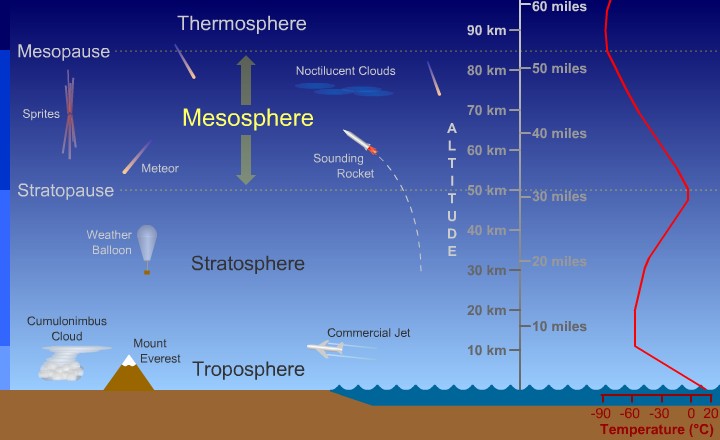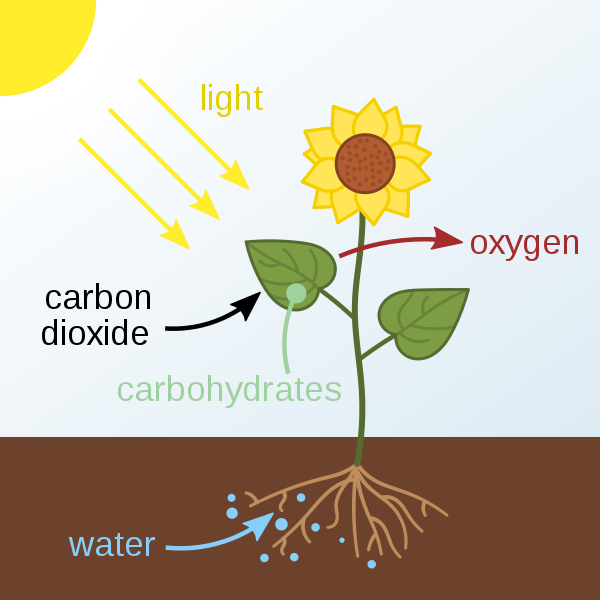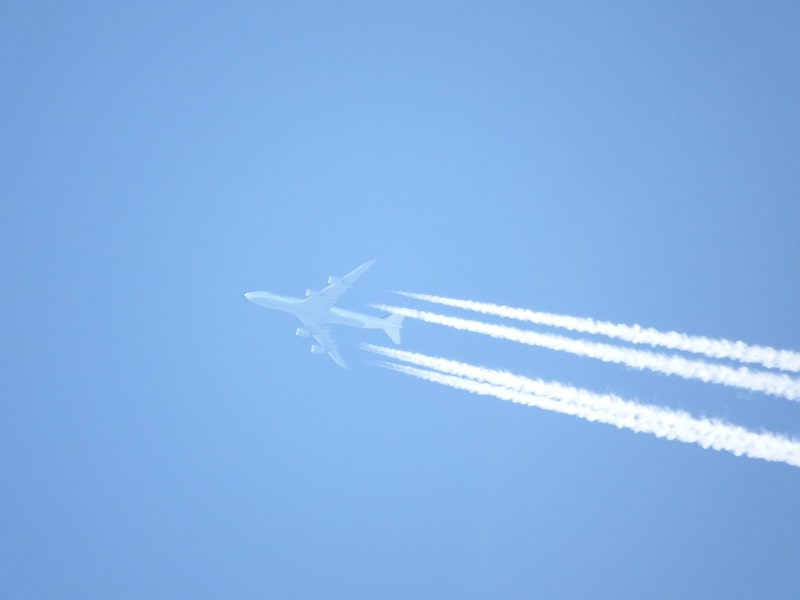Last updated on September 7th, 2023
The atmosphere is a layer of gases retained by gravity on the earth. It surrounds the globe and protects it by absorbing the infrared rays from the sun. Moreover, it regulates the temperature extremes that are likely to occur between day and night. The shiny blue marble continues to fascinate us since the time we began walking across its surfaces. Interestingly, the most significant portion of the atmosphere is located within twelve kilometers of the earth’s surface. Here are 50 Interesting facts about the atmosphere that you probably didn’t know.
1. The atmosphere is about 500 km thick, with a mix of more than ten different gases. It is made up of 78% nitrogen and 21% oxygen. Other gases such as carbon dioxide, argon, helium, and neon occupy the remaining portion.
2. Ninety-nine percent of the gases that compose the atmosphere are located below a height of 32 km (20 miles).
3. These gases are chemically inert, although some can react with various chemicals: carbon monoxide, sulfur dioxide, methane, ammonia, ozone, and water vapor. These elements react with toxic gases, salt, smoke, and volcanic ash.
4. The atmosphere comprises five layers: troposphere, stratosphere, mesosphere, thermosphere and exosphere.

5. Troposphere is the thinnest and closest layer to the earth’s surface. It contains 80% of the atmospheric weight, making it the densest layer.
6. As you go up, it becomes colder. The temperatures decrease by 6.5 degrees Celsius each kilometer, reaching -55 degrees Celsius at the top limit of the troposphere, commonly known as the tropopause.
7. Meteorological phenomena are limited to the troposphere since they result from the earth’s rotation and sun’s radiation on the atmosphere. The wind, which is the air current, is generated when the hot air rises and gets replaced by colder air.
8. Stratosphere is the second layer. It extends above the tropopause to an altitude of 50 km above the earth. Its upper edge has maximum ozone concentration, referred to as the ozone belt. The temperatures in the ozone belt are higher than in the troposphere since the ozone absorbs the ultraviolet rays.
9. Air pollution causes the demolition of the ozone belt, and without it, the earth would be exposed to the deadly ultraviolet rays in the sun. Planes fly in the stratosphere to avoid turbulence and fly longer distances using less fuel. Stratopause is the connection between the mesosphere and stratosphere.
10. Mesosphere lies between 50-85 km above sea level. Temperature decreases with height throughout the mesosphere. The coldest temperatures in Earth’s atmosphere, about -90° C (-130° F), are found near the top of this layer. Ice clouds form in this layer which is visible when lighted from beneath during sunset. Moreover, meteorites falling over the earth burn in this layer.
11. The thermosphere extends from about 90 km to 500 km and 1,000 km above our planet. It comprises the magnetosphere and ionosphere. Air density is the lowest, and its temperature can increase up to 1500 degrees Celsius. It is in the thermosphere that the space shuttle flew.
12. Ionization takes place in the ionosphere caused by the sun’s radiation. The particles in this layer are electrically charged, and when they hit each other, aurora australis can be observed. It helps in propagation of the radio waves used in telecommunication.
13. At the outer limit of the magnetic field is the magnetosphere. It is like a giant magnet and retains high-energy particles, thereby protecting the earth. Air density in this layer gradually decreases as you go higher.
14. Exosphere widely contains particles of helium and hydrogen. It is the highest layer. The air has a very low density that you get into the interplanetary space without a manifest limit. This layer separates the rest of the atmosphere from outer space. It’s about 6,200 miles (10,000 kilometers) thick. That’s almost as wide as Earth itself. The exosphere is really, really big.
15. The atmospheric balance is jeopardized by human activities that cause global warming, greenhouse effect, ozone belt destruction, air contamination, and acid rains. The burning of fossil fuels discharges carbon dioxide, while agricultural developments deposit a lot of methane and nitrogen oxides into the atmosphere.
16. Biosphere forms part of the troposphere where life exists. The biosphere extends from the deepest root systems of trees, to the dark environments of ocean trenches, to lush rain forests, high mountaintops, and transition zones like this one, where ocean and terrestrial ecosystems meet.

17. The photosynthesis process enables plants to take up carbon dioxide and release oxygen into the atmosphere.
18. The atmospheric gases must retain the heat in the sun rays and reflect them to the earth to keep it warm. Without it, the earth’s surface would be so cold that living here would not be possible. The greenhouse gases increase the effect making the earth’s surface to be warmer than usual.
19. A good percentage of the earth’s population breathes contaminated air, primarily sulfur dioxide and carbon monoxide emitted by industrial factories. It has increased the number of respiratory conditions such as asthma.
20. Acid rains form when nitrogen oxide or Sulphur dioxide combines with water vapor in the atmosphere. Acidic rains destroy plants and animals, and if it reaches rivers and lakes, it destroys all the aquatic life.
21. Skin cancer frequency is increasing due to the thinning of the ozone layer. When greenhouse gases rise into the atmosphere, they form chloride ions that destroy the ozone layer by making holes in it.
22. As the altitude increases, the atmosphere diminishes which is the reason why the air pressure in the exosphere is shallow. Moreover, the distance between the molecules increases as you move up the different layers.
23. At an altitude of 100 km above sea level, a border represents the separation between the atmosphere and outer space. This border is known as the Karman line. In the 1900s, Hungarian physicist Theodore von Kármán determined the boundary to be around 50 miles up, or roughly 80 kilometers above sea level. However, the distance of 100 kms from the earth’s surface is what is considered generally as “an imaginary boundary”. In fact it is not easy to distinguish between “space” and “not space” because of the fact that the Earth’s atmosphere doesn’t simply vanish; rather, it gradually becomes thinner and thinner over about 600 miles.
24. Ozone layer lies about 19-32 km over the earth’s surface. Ozone is a blue pungent-smelling gas that helps to absorb the ultraviolet radiation in the sun rays. In 1985, they observed a hole in the ozone layer above the Antarctic. Luckily the situation has improved since the ban of chlorofluorocarbon.
25. A single chlorine atom can destroy more than a hundred thousand ozone molecules. The destruction of the ozone layer lets an enormous amount of ultraviolet rays reach the earth, which leads to skin cancer and cataracts in humans and animals alike.

26. Aurora is also referred to as polar light. It is seen in high latitude areas as shimmering curtains of lights that are visible at night. They result from ionized particles from the sun striking the upper atmosphere above the poles.
27. Sunlight is reflected in every direction by the gases present in the atmosphere. Since blue light has short wavelengths, it gets reflected more compared to other colors. It is the reason why the sky appears blue. From space, the earth is seen as a blue halo.
28. The temperatures at the different atmospheric layers differ depending on solar radiation, humidity, and altitude. The presence of moisture in the atmosphere is
measured by the humidity of the air.
29. The coldest temperatures are found in the mesopause. In comparison, the warmest in the thermosphere. Temperature increases with height until the estimated top of the thermosphere at 500 km.
A list of the eleven most abundant gases found in the Earth’s lower atmosphere by volume
| Serial | Gas Name | Chemical Formula | Percent Volume |
|---|---|---|---|
| 1. | Nitrogen | N2 | 78.08% |
| 2. | Oxygen | O2 | 20.95% |
| 3. | *Water | H2O | 0 to 4% |
| 4. | Argon | Ar | 0.93% |
| 5. | *Carbon Dioxide | CO2 | 0.0360% |
| 6. | Neon | Ne | 0.0018% |
| 7. | Helium | He | 0.0005% |
| 8. | *Methane | CH4 | 0.00017% |
| 9. | Hydrogen | H2 | 0.00005% |
| 10. | *Nitrous Oxide | N2O | 0.00003% |
| 11. | *Ozone | O3 | 0.000004% |
| Table last updated | July 23, 2021 | *variable gases | |
| Table data source | http://tornado.sfsu.edu/ |
30. Meteors burn up in the coldest layer, the mesosphere. As a meteor begins to enter this layer, it rapidly bumps into mesosphere particles and scrapes against them. Due to the high speed of the meteor, it generates a lot of heat resulting from high friction between the particles and the meteor. It starts to glow, and the rocks begin to fly off.
31. Ionosphere plays a vital role in radio signals broadcast on the earth’s surface. Geomagnetic solar storms caused by solar flares or solar winds can disrupt activities in the ionosphere, causing difficulty in transmitting radio signals and global positioning system signals.
32. Although the sun and other planets have magnetospheres, the earth’s magnetosphere is the strongest one of all the rocky planets. Its magnetic field goes up to 60,000 km into space. Also, magnetic and south poles reverse at uneven intervals of hundreds of thousands of years.
33. The particles in the exosphere do not behave like gases. They are far much apart from that they can move thousands of kilometers without colliding. These free-moving elements continuously escape into space due to ballistic trajectories.

34. You might have seen planes leaving white condensation trails. These are generated when cold atmospheric air blends with the hot, humid exhaust. Within no time, the vapor from the exhaust freezes and turns visible. The contrails usually become thin at low humidity and high altitudes. The more humid the atmosphere is, the thicker the contrails will be. They are much similar to warm breath during cold weather.
35. The atmosphere has nearly 37.5 million billion gallons of water at any given time. The water exists in the form of vapor and invisible to plain eyes. It is enough to cover the entire earth’s surface with 1 cm of rain. Each year, this large amount of water is recycled about 40 times. If you do your calculations, each water vapor particle spends approximately nine days in the atmosphere.
. . . continue reading on the next page
